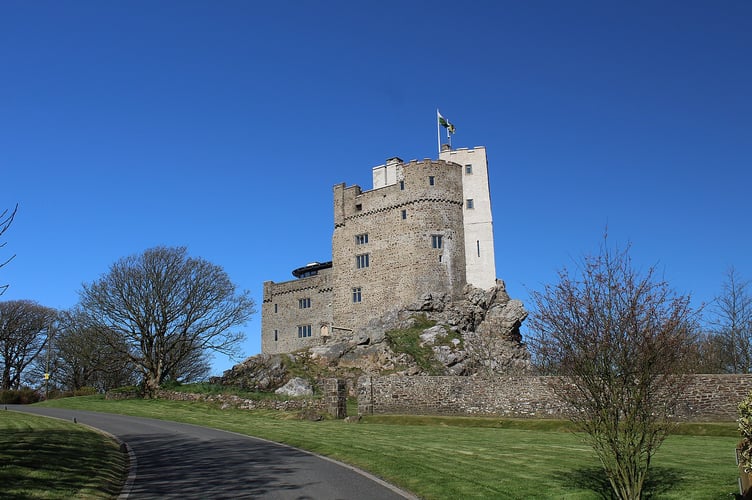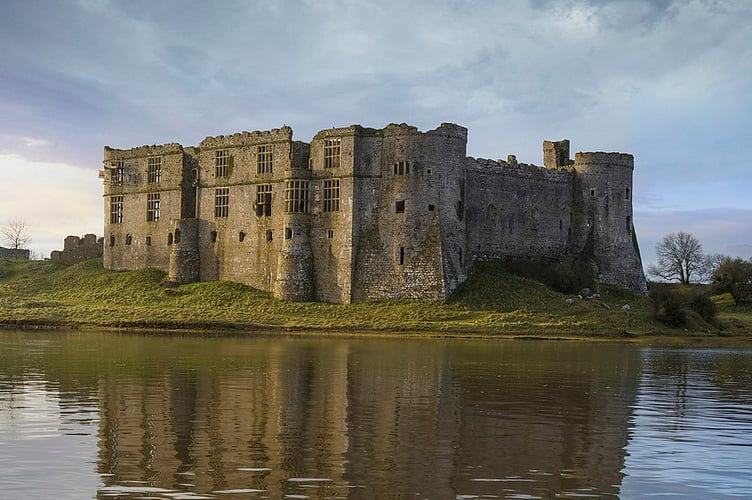From deathly apes to famous poets, Tenby and Pembrokeshire’s ghostly past is as varied as it is intriguing.
All manner of creatures and figures find themselves protagonists in the tale of this area, even after their death.
Roch Castle
This castle is steeped in story and rumour.
Legend has it that the first Lord of Roch Castle’s death was fortold by a witch. She told him that he would die from an adder bite, but if he could survive for one year, he would be safe.
Lord Roch remained inside his castle walls from that moment, living in the upper rooms. However, as the period of a year drew to a close, the weather turned bitterly cold. In his bid to keep warm he sent for wood for a fire. When the brushwood was brought back, a hibernating adder was amongst the branches. When the fire was lit, the adder was awoken from its slumber, and bit the unfortunate Lord Roch. The prophesy was fulfilled.
Today, the castle is said to be haunted by Lucy Walter, who was born in the castle in 1630, and later became a courtesan of Charles II.
She bore him a son, James, whom Charles made Duke of Monmouth and who would grow up to become the ill-fated leader of the 1685 Monmouth rebellion and be beheaded at his end.
Perhaps it is the fate of her son that brings Lucy Walters back to Roch Castle where, in a white dress, she hovers in the corridors, gliding effortlessly through walls and locked doors.

Aberglasney House and Gardens
This house has been visited many times by ghost hunters, paranormal specialists, and TV programs.
One day in the 1630’s, a housekeeper saw five candles floating in the house's newly plastered "blue room."
The next morning, five maidservants were found dead in their beds there. A charcoal stove, left burning to speed the drying of the plaster, had asphyxiated them as they slept.
Over the following centuries, these candles became one of Aberglasney’s most abiding legends. They became notorious as a dreadful omen of approaching death.
In 1803 Thomas Phillips, a surgeon with the East India Company, purchased Aberglasney. Following his death in 1824, his phantom was soon seen flitting about the house and grounds.
Over the years he has appeared to gardeners, servants and tradesmen, whilst more recently, guides at the property have heard his ghostly footsteps.
Following Thomas Phillips' death, successive owners found their lives blighted by ill luck with career, children, and health. Most recently, workers saw a girl standing in a corner of the basement, apparently cooking and guides would hear footsteps.
It is in Pigeon House Wood at the rear of the property, that the most disturbing phenomenon is experienced.
There is a certain area, where many sense a feeling of overwhelming apprehension. It intensifies as they continue on the path until, at the edge of the wood, it is replaced by sudden fear, followed by an eerie coldness.
A medium, visiting the property in 1999, said that she ‘sensed someone trying to evade capture in the wood. Where people begin to feel uneasy,’ she explained, ‘was where his pursuers had spotted the fugitive. He made a desperate run for freedom, but was killed by a single bullet, at the spot where the sudden fear and coldness is most often felt.’
Dylan Thomas’s Boathouse
You may recognise the namesake line of the haunting poem: Do Not Go Gentle into that Goodnight. It was written by Dylan Thomas in this blue painted work shed that perches precariously at the very edge of the cliff.
He died in November 1953 while on a lecture tour of America.
With his widow Caitlin unwilling to live in the boathouse his mother, Florence, became the tenant, staying until she died here in 1958. It is her ghost that is believed to haunt the house.
Staff have often been surprised when opening the premises in the morning to hear the sound of a chair scraping over the floor upstairs, as though someone has quickly risen from a table ‘to avoid them.’
Staff will find that lights that were absolutely switched off have mysteriously been turned on overnight, while books have been knocked off shelves and, on occasions, pictures have been lifted from the walls and moved on to the opposite side of the upstairs room.
Pembroke Castle
One of the most famous ghost stories in Pembrokeshire is that of Pembroke Castle. This imposing fortress, dating back to the 11th century, is said to be haunted by the ghost of a young girl named Maud. Legend has it that Maud fell in love with a young knight who was stationed at the castle. Tragically, the knight was killed in battle, leaving Maud heartbroken. It is said that her ghost can still be seen wandering the castle grounds, searching for her lost love. Visitors to Pembroke Castle have reported hearing disembodied whispers and feeling a chilling presence in certain areas of the castle.
Carew Castle
Another eerie tale comes from within the walls of Carew Castle, a medieval stronghold on Carew River.
According to local legend, the ghost of Sir Roland Rhys, a former owner of the castle, haunts its ancient halls. Sir Roland was known for his tyrannical rule and cruel treatment of his tenants. It is said that his ghost now seeks redemption for his past deeds and can be heard moaning and wailing throughout the castle. Visitors to Carew Castle have reported unexplained cold spots and sudden drops in temperature, as well as feeling an overwhelming sense of sadness in certain areas.
On dark and stormy nights, it is reportedly also visited by the ghost of an ape! Other spirits include a Celtic warrior, a kitchen boy who clatters pots and pans and a white lady named Princess Nest.

Tenby
The atmospheric town of Tenby itself is home to a Sunday Times as one top five ghost walks in Britain. With witches, fairies, eccentric Pembrokeshire customs, omens, mysteries, murder and – of course – ghosts.



